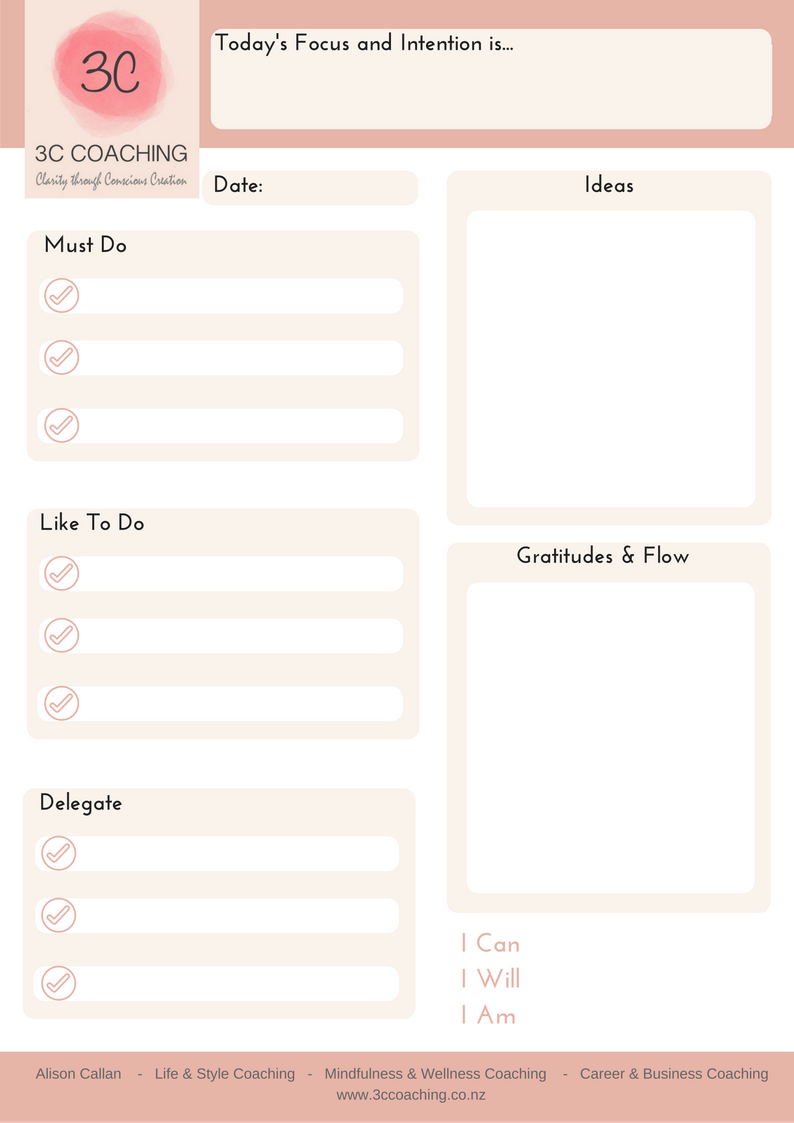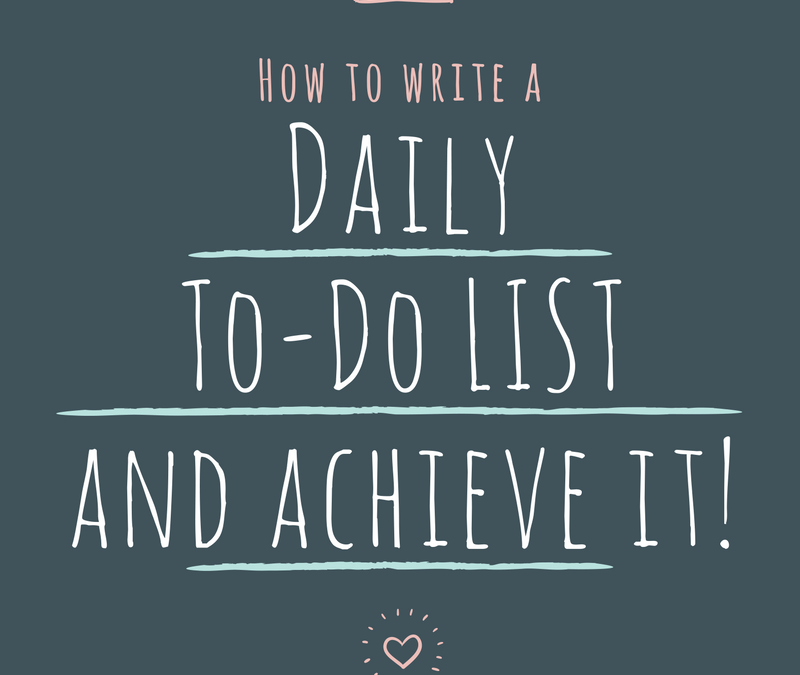A great way of getting your plans clear in your mind is to write them down, which enables you to see your actions and prioritise them. To do this the majority of you will write a ‘To-Do’ list, with the hopes of completing it all in record time, which usually doesn’t occur. And as such ‘To-Do’ lists have started to get a bad rap. However, there are a few insights that I share with my Clients to help them better plan and prioritise their day so that they achieve and flow in equal measure, making their days much more organised, guaranteed to start right and feel good because they achieve what they set out to!
So when you start writing your ‘To-Do’ list, how many of you end up with a huge list to achieve at the outset of your day and barely manage to cross anything off, and you even end up adding more as the day goes on? I’m guessing this will resonate with a lot of you, and it certainly used to with me as well, until I changed a few thing about my list, which I’ll tell you about shortly.
But first let’s start with the basics. The purpose of creating a ‘To-Do’ list is to get all your plans and visions and required actions out of your head and down on paper so you can make efficient and effective decisions, by way of seeing your tasks and therefore plan your valuable time accordingly. Calling it a ‘To-Do’ list though is possibly the first issue, it gives you a false sense of overwhelm, feeling that you must achieve all that you have listed, which doesn’t get you off to a good start. Coupled with the fact your so called ‘To Do’ list is usually tasks to achieve on top of what you see as your routine actions or tasks. So you can see how this immediately starts to build up. So how about we switch it up and call it your ‘Plan’ or ‘Daily Priorities’ instead? All of a sudden just with the name change alone it provides a sense of ease, don’t you think?
The next thing I’d like to draw your attention to is the time of day that you happen to create your list. I’m guessing it is a first thing in the morning task that you set, hoping that it will get you in the zone to achieve and you write it while you look over your diary for the day. Well let me stop you there. I have suggested to numerous Clients and have had great results and feedback from this suggestion Im about to pose to you, so listen up – Write your list at the end of your working day, for the following day, let it be the final thing that you do to close that aspect of your work mind and set your plan for the next day. The reason this works so well is that you feel able to finish what you’re doing there and then as you have already got your plan sorted for the following day, so when you arrive in the morning you are set, ready to go and have clarity about what you are going to achieve. If you do nothing else from my suggestions except this one, you will notice a big shift in your competencies to plan, feel organised and in control and have the added bonus over time of leaving work at work.
The next suggestions are actually ways in which to write your list. If you create five columns and write the headings accordingly; (or you can scroll to the bottom and download the sheet Ive created for you.) 
- Must Do
- Like To Do
- Delegate
- Ideas
- Flow & Gratitudes
When you start your list, you will need to categorise the task or item under one of these headings, have a read of the descriptions:
Must Do
A ‘Must Do’ item is something that is plaguing you. You know that nagging task that you’ve been putting off but simply must get done. It is a task that is secretly holding you back from moving forward as its always there lurking and is usually left to the very last minute thanks to your old friend procrastination. Well, nows the time to face it and place it under this column, especially if it has a looming deadline or someone else is waiting on you to take action. If you are not sure if it is a ‘Must Do’ then ask yourself the following – If I were to get this actioned and be able to move past it, how would I feel? If the answer is an overwhelming sense of relief and a release in your body, then do not hold back it’s likely to fit here.
Like To Do
This is usually where a lot of little, shorter tasks sit. Things which are easier to seem important in order to enable procrastination to hang around a bit longer putting off those unenjoyable ‘Must Do’ tasks. The items categorised here are not necessary to achieve today, but they are on your radar for at least getting through this week. This is where you have to be honest with yourself about the validity of the items you place here, ask yourself the following – What would be the result if I achieved these later in the week? If the answer is not very much, and there’s no overwhelming feelings of resistance attached to the task it’s probably safe to say its in the ‘Like To Do’ column.
Delegate
This can be a tricky one, as my list loving individuals are not great at sharing tasks – accountability and control is strong within them. However, this is a key component of being able to tackle more tasks during your week. You need to look at the tasks you’ve already assigned to the two previous columns and ask yourself the following – Am I the only person, realistically, who could action this task in full or partly? It may seem hard to face, as we all like to feel as though we are the only ones capable of taking on our list, but we usually have a whole team of people surrounding us in life who are happy to pitch in. So you should ask them where reasonable. If you truly have a difficult time with this concept then imagine how you feel when a colleague or loved one asks for your help with something – yup it usually feels great! Someone needs you, they trust you and rely on you and you’re honoured and happy to help. Now imagine being the person to give that feeling to another, thats pretty special. So step up and ask for help, delegate and you could just make someones day in the process as well as free up your time for tasks only you can achieve – genius right?!
Ideas
Throughout the day we have a lot of inspiration and creative ideas, you need a space to capture them to develop at a later date. The thinking here is that you do not want to get sidetracked by your ideas and enable them to stop you from achieving your ‘Must Do’ tasks. So jot them down in a safe space, knowing that you can come back to them later and create from them tasks for the other columns.
Flow and Gratitudes
I Love this column, as in my day I actually achieve a lot but I tend to overlook it as a routine part of the day or as a moment of greatness but then I move my focus back to something else and it becomes lost. So I created this column to capture all the things you achieve in your day just through ‘Going with the Flow’, this can often show you how productive the day was in itself. And of course in line with ‘Going through the Flow’ is Gratitudes – things that happen and you are grateful for them. These are the moments you need to bask in to keep the momentum going for the first three columns and generally keep you in touch with the meaning of your day.
So there you have it, my suggestions for writing your Daily Plan or Priorities list. The tips to remember:
- If you start working on your most difficult or least favourite ‘Must Do’ task first you will achieve something big earlier in your day. So that once it is completed you will have a much easier and free flowing day managing your other ‘Like To Do’, ‘Ideas’ and ‘Flow and Gratitude’ columns.
- Keep your expectations small. You can always add to your list, but you need to start with one step before looking to conquer the mountain.
- Be honest with yourself about what you need to do personally, and honest about what is something you’d ‘Like To Do’. Focus instead on the result you want to achieve and why to help keep you true to your allocations of tasks.
- Write your list for the next day the evening before to get you clear and focused and finished for that day, knowing you’re organised and prepared for the next.
- Change the name of your list from ‘To Do’ to something lighter like ‘Daily Plan’ or ‘Priorities’.
- Remember to include in your list all the things you need to achieve in the day including what you deem to be your general or routine tasks – you will then acknowledge all of the work you do, along with your ‘Gratitudes and Flow’ and have a much clearer picture of your achievements!
Have a go at these techniques and let me know how they work for you, I would love to hear how you have incorporated them into your planning or the successes you now achieve as a result.
And my gift to you, a printable planning sheet, click here.
Happy planning and achieving!
With warmth – Alison
P.S – Keep your eyes peeled for my next blog on how to get your Mindset actively ready for the day and the importance of being aware of your Mindset.
If you are looking for more Goal based assistance please check out my blog post here on ‘7 Steps to Create your Goal and Stick to it!‘ These steps can be interwoven into your daily planning and work alongside it nicely when managing a long term Goal.

